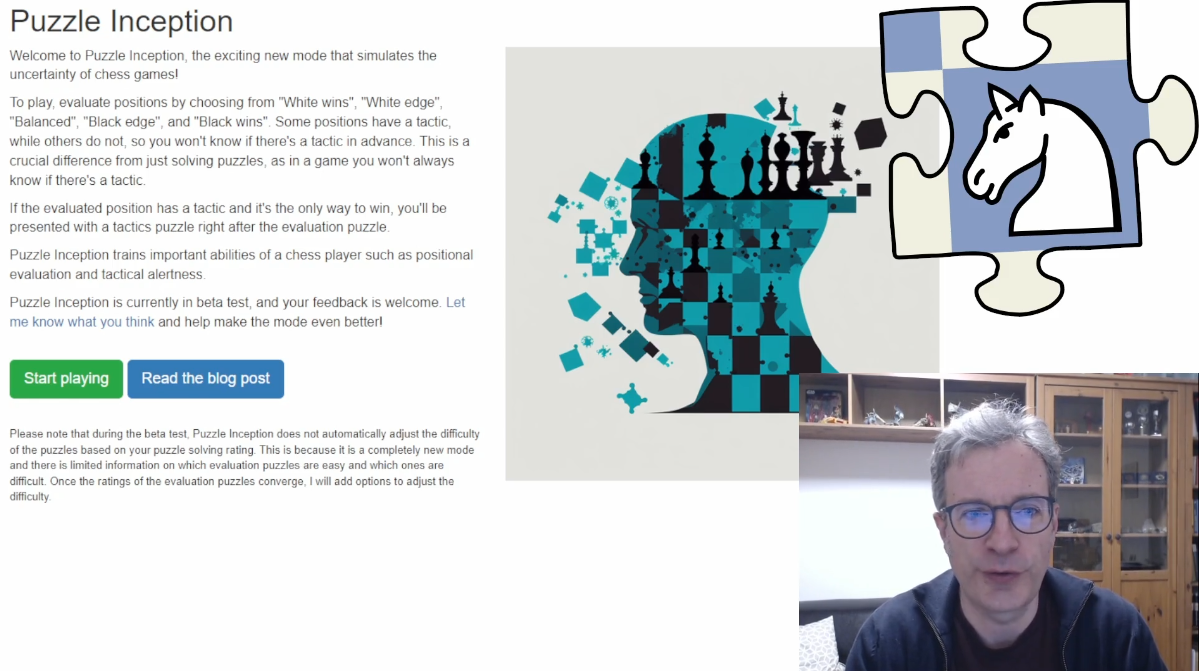Customize your chess training with the Puzzle Filter

Customize your chess training with Puzzle Filter
In this blog post, I'll walk you through how to use the Puzzle Filter, showcase some interesting examples, and offer tips to help you get the most out of this invaluable feature. Take your chess skills to the next level with the Puzzle Filter!
Introduction
The Puzzle Filter has been a powerful tool for chess players for years, and I'm excited to bring you even more ways to customize your training experience. With recent additions, such as new checkmate patterns, expanded motifs, and the option to select a specific color, the Puzzle Filter offers even more opportunities to focus on the motifs, openings, endgames, and player styles that matter most to you.
The Puzzle Filter is designed to help you unlock the full potential of your chess training by allowing you to create personalized practice sessions tailored to your needs and preferences. Whether you're looking to improve in specific motifs, sharpen your endgame technique, or study tactics of your favorite players, the filter puts the power in your hands. By focusing on the areas that you want to strengthen, the Puzzle Filter helps you make the most of your training time, leading to more rapid improvement and a deeper understanding of the game. Read on to learn more about this versatile feature and discover how it can transform your chess training experience.
Video
Watch a video with examples of how to use the Puzzle Filter to customize your chess training.
Examples
Here are some example puzzles featured in the video:
Easy queen forks
White checkmates in the Sicilian dragon
Winning pawn endgames
Updates to the Puzzle Filter
Puzzle Filter was recently updated with additional checkmate patterns and motifs.
The following checkmate patterns were added: Blind swine mate, double check mate, double knight mate, Mayet's mate, Morphy's mate, dragonfly mate, triangle mate, fools mate, xray mate, Damiano's rook mate, and Damiano's knight mate.
The following motifs are now available: Capture defender, discovered check, attack defender, trade and fork, trade and pin, trade and skewer, trade and discovered attack, opening line for fork, opening like for checkmate, use the pin, opening line for fork attack, opening line for checkmate attack, attack blocker of promotion, clearance into promotion, clearance into fork, clearance into pin, clearance into skewer, clearance into checkmate, clearance into trapping pice, and intermediate move.
A new option was added to filter puzzles so that you are only solving puzzles for the white, or the black side. This is especially useful when selecting a specific opening.
Puzzle Filter and Puzzle Academy
Puzzle Filter and Puzzle Academy each offer unique advantages for your chess training. While the Puzzle Filter allows you to focus on specific players and openings, it requires prior knowledge of the areas you need to improve. On the other hand, Puzzle Academy features a skill tree and tracks your progress on each motif. Based on your performance, it creates personalized training sessions and recommends the next motifs to learn, providing a more guided and tailored experience. By combining the targeted practice from the Puzzle Filter with the adaptive nature of Puzzle Academy, you can enjoy a comprehensive and effective training plan that caters to your individual needs. Join Premium and unlock the full potential of both tools in your chess journey.
Tips for getting the most out of Puzzle Filter
- To keep your training varied and engaging, explore the many options of the filter. Try mixing different motifs or selecting a range of difficulty levels during a session.
- Analyze your recent games and identify areas where you struggle or make frequent mistakes. Use the Puzzle Filter to focus on specific motifs or openings that address these weaknesses.
- Take breaks and review: After solving a puzzle, take a moment to review the solution and understand the underlying principles. This will help reinforce your learning and improve retention.
- Practice tactical motifs in openings: When learning an opening from a book or an online course, make sure you not just learn the opening moves and ideas, but also practice frequently occurring tactical motifs associated with that opening. Use the opening filter and various difficulty settings to sharpen your skills and gain a deeper understanding of the opening's intricacies.
Conclusion
In conclusion, Puzzle Filter offers a powerful and customizable way to hone your chess skills by focusing on specific motifs, openings, and difficulty levels. Combined with the personalized training and progress tracking of Puzzle Academy, you'll be well-equipped for a comprehensive chess training experience. I encourage you to try Puzzle Filter and discover the wealth of training possibilities it offers. I'm always eager to hear your feedback and suggestions, so please don't hesitate to share your thoughts with us. Happy puzzling, and here's to taking your chess game to new heights!

Thursday, May 4, 2023
Last updated: Tuesday, July 8, 2025
Martin Bennedik
Founder of ChessPuzzle.net, International Correspondence Chess Master
Related posts
Introducing Checkmate Armageddon: A Timed Chess Puzzle Mode to Save the World!
In this unique and engaging timed mode, you'll be tasked with solving as many checkmate in one puzzles as possible, sending demons back to the shadows with each victory. Are you ready to unleash your inner chess hero and put your checkmate pattern recognition to the test? Read on to learn more about Checkmate Armageddon and how it can enhance your chess experience!Press Release about Puzzle Inception
ChessPuzzle.net introduces Puzzle Inception, an innovative new mode that helps chess players train positional evaluation and tactical alertnessIntroducing Puzzle Inception: The Future of Chess Puzzles
Want to train more than just tactics? Puzzle Inception is here! This exciting new puzzle mode lets you practice positional evaluation and tactical alertness, all in one package. Try it out for free during the open beta!

